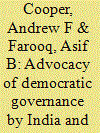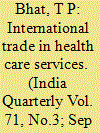|
|
|
Sort Order |
|
|
|
Items / Page
|
|
|
|
|
|
|
| Srl | Item |
| 1 |
ID:
140386


|
|
|
|
|
| Summary/Abstract |
This article examines the patterns of consistency and inconsistency between how India and China advocate democratisation at the global and national levels. Addressing this question through a dualistic framework, we develop a detailed map of the rhetorical promotion of democratic governance by India and China through an analysis of 10 years of foreign affairs speeches, remarks, interviews and statements of political elites of both countries. The article argues that although China has not shied away from declarations on democracy domestically as well as on global governance, the contradictions between the clear and consistent push for democracy and equity at the global level and the highly contingent commitment to democracy at the national level remain highly salient. India’s deficiencies, by way of contrast, come not in the domain of legitimacy but effectiveness. India’s struggle to translate its domestic democratic credibility into more equitable representation at the global institutional level and into a stellar economic model at the domestic level exposes it to criticism in relationship to China. Yet, even with these gaps, the article concludes that India has some comparative advantages over China precisely because it can play a consistent two-level game in terms of the promotion of democracy both at global and state levels.
|
|
|
|
|
|
|
|
|
|
|
|
|
|
|
|
| 2 |
ID:
140385


|
|
|
|
|
| Summary/Abstract |
India and Australia held a set of largely divergent strategic perspectives during the Cold War period, which prevented any significant strategic relationship from developing at that time. Since the end of the Cold War, however, strategic relations between the two countries, although still volatile, have steadily improved. This article argues that as the Indo-Pacific region is increasingly seen as an arena of strategic importance in both New Delhi and Canberra, there is increased scope for a further convergence of Indo-Australian strategic relations based on a series of shared core security concerns. However, in the context of a rising China and re-assertive US in the region, there is a danger that bilateral relations between each of the two countries and the US may serve to prevent a strengthening of independent Indo-Australian relations. First, the post-World War II security policies of both India and Australia are outlined, as are the places occupied by each country in the strategic perspectives of the other. Then, the post-Cold War convergence of security perspectives of both nations is examined in the context of the emerging importance of the Indo-Pacific region in terms of both non-state security challenges and traditional balance-of-power concerns. Finally, the pressures exacted on potential Indo-Australian strategic relations by a rising China and re-assertive US are considered. It is argued that although convergence has begun, India and Australia still have a long way to go before they can initiate a robust and independent bilateral security partnership.
|
|
|
|
|
|
|
|
|
|
|
|
|
|
|
|
| 3 |
ID:
140384


|
|
|
|
|
| Summary/Abstract |
The Indian military is the world’s fourth largest after the US, Russia and China. In the immediate aftermath of India’s independence from British rule, however, it was hard to imagine that in the span of six decades, a poverty-stricken, fragmented and deeply traumatised country would emerge as a military powerhouse. How and why has this transformation taken place? Has India’s growing military prowess resulted in a more robust and adventurist foreign policy, particularly within the South Asian region? What does India’s rapid military transformation, particularly the Indian Navy, in the twenty-first century say about India’s perception of threats to national security? In this article, I argue that the Indian military’s expansion and modernisation has happened in phases, mainly as a reaction to threatening developments within the surrounding region, the evolving global strategic environment and the perceptions and decisions taken by India’s political elites. I argue, further, that as India’s military prowess and self-confidence have grown, Indian leaders have at times felt tempted to flex the military muscles, particularly in low-intensity regional conflicts, but not always with expected results. I conclude that in the twenty-first century, the Indian military, particularly the Indian Navy, is undergoing rapid expansion and transformation. This suggests that in addition to threats coming across the western and northern land borders with Pakistan and China respectively, India’s security planners envisage a growing threat to national security emanating from the deep waters of the Bay of Bengal, the Arabian Sea and the Indian Ocean.
|
|
|
|
|
|
|
|
|
|
|
|
|
|
|
|
| 4 |
ID:
140387


|
|
|
|
|
| Summary/Abstract |
In the last two decades, international trade in health care services has expanded under the GATS. It has acquired new dimensions with the application of advanced information and communication technology and cross-border mobility. India is a participant in the GATS and has made binding commitments to minimise trade barriers. Under GATS, trade liberalisation is effected through four modes: mode 1 represents cross-border supply; mode 2, consumption abroad; mode 3, commercial presence; and mode 4, presence of natural persons. Though all modes are not totally free and are subject to restrictions, India enjoys certain distinct advantages, especially under modes 2 and 4. India has emerged as a hub for clinical research, has established superiority in IT-enabled and back-end services and has built a reputation in offering an array of specialised medical and surgical interventions at affordable prices, which have boosted medical tourism. The global health care market is highly competitive; therefore, there is a need for suitable export strategies to effectively tap into the potential of the individual markets.
|
|
|
|
|
|
|
|
|
|
|
|
|
|
|
|
| 5 |
ID:
140388


|
|
|
|
|
| Summary/Abstract |
The recent political developments in the Arab world, in general, and in the North African states like Tunisia, Egypt and Libya, in particular, develop new enthusiasm on the interaction between Islam/Islamism/Islamic movements and democracy; especially with the institutions and practices of western liberal democracy. Islamist groups have become a critical factor in the larger politics of those states and the central focus of any serious debate on political liberalisation and democratisation in the Arab world. The 1990s witnessed a revival of Islamism in the political sphere through the increasing participation of Islamists in elections and the democratic process. It has raised some new debates on the fundamental question of the compatibility of Islam and democracy. Such debates, at times, challenged the dominant western pre-supposition that Islam and democracy are incompatible. It has become crucial in the widely discussed ‘post September 11’ global context where many groups in the west project Islamism and Islamic movements as the biggest threat to modern liberal–democratic states. The Algerian experiment with democracy in the late 1980s, which this article discusses in detail, was the first such experiment in the Arab world where Islamists actively participated in a liberal democratic election process. The developments that had taken place after the victory of Islamists in this election were crucial in framing an Islamist approach to democracy thereafter.
|
|
|
|
|
|
|
|
|
|
|
|
|
|
|
|
|
|
|
|
|